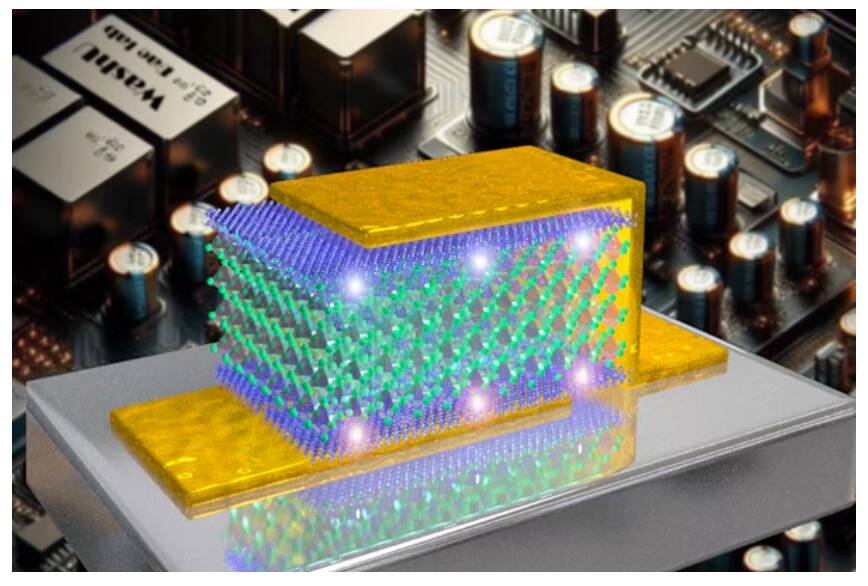Breakthrough in the world of capacitors: super-performing materials pave the way for new electronics

Scientists at Washington University in St. Louis have developed a new material that enhances the ability to store electrostatic energy . The material consists of artificial heterostructures made of independent 2D and 3D membranes, which have an energy density up to 19 times higher than commercially available capacitors. This will allow us to build highly innovative capacitors and change the way electronics work. Head of the research is Professor Sang-Hoon Bae who described this new material to Science .
Electrostatic capacitors play a crucial role in modern electronics. They enable very fast charging and discharging, providing energy and power storage for devices ranging from smartphones, laptops and routers, to medical devices, automotive electronics and industrial equipment. Their function on the one hand is to filter and stabilize the electrical signals, eliminating disturbances, and on the other to accumulate energy in order to release a controlled impulse when required. This second point makes the power that can be accumulated by the capacitor important.
However, ferroelectric materials used in capacitors have significant energy loss due to their material properties, making it difficult to provide high energy storage capacity.

Artificial heterostructures consisting of independent 2D and 3D membranes developed by Sang-Hoon Bae's laboratory have an energy density up to 19 times higher than commercially available capacitors
Bae and his collaborators, including Rohan Mishra, associate professor of mechanical engineering and materials science, and Chuan Wang, associate professor of electrical and systems engineering, both at WashU, and Frances Ross, TDK Professor in Materials Science and Engineering at MIT, introduced an approach to control the relaxation time – an internal material property that describes the time it takes for charge to dissipate or decay – of ferroelectric capacitors using 2D materials.
The team developed new 2D/3D/2D heterostructures that can minimize energy loss while retaining the advantageous material properties of 3D ferroelectric materials. Their approach cleverly blends 2D and 3D materials into atomically thin layers, with carefully thought-out chemical and non-chemical bonds between each layer. A very thin 3D core is sandwiched between two outer 2D layers to create a stack only about 30 nanometers thick. This is about one-tenth the size of an average virus particle. Practically, sandwiches are made of materials with alternating two- and three-dimensional atomic structures whose qualities in energy conservation are unique.
“We created a new structure based on the innovations we have already made in my lab with 2D materials,” Bae said. “Initially, we weren't focused on energy storage, but while exploring the properties of materials, we found a new physical phenomenon that we realized could be applied to energy storage, and it was very interesting and potentially much more useful” .
The 2D/3D/2D heterostructures have been finely crafted to sit at the balance point between conductivity and non-conductivity, where semiconductor materials have optimal electrical properties for energy storage. With this design, Bae and his collaborators reported an energy density up to 19 times higher than commercially available ferroelectric capacitors, and achieved an efficiency of more than 90%, also unprecedented.
“Basically, the structure we have developed is a new electronic material,” Bae said. “We are not yet 100% optimal, but we are already outperforming other labs. Our next steps will be to further improve the structure of this material, so that we can meet the need for ultra-fast charging and discharging and very high energy densities in capacitors. We need to be able to do this without losing storage capacity over repeated charging, to see this material used widely in large electronics, such as electric vehicles, and other developing green technologies.”

Thanks to our Telegram channel you can stay updated on the publication of new Economic Scenarios articles.
The article Breakthrough in the world of capacitors: super-performing materials pave the way for new electronics comes from Scenari Economici .
This is a machine translation of a post published on Scenari Economici at the URL https://scenarieconomici.it/svolta-nel-mondo-dei-condensatori-materiali-super-performanti-aprono-la-strada-a-una-nuova-elettronica/ on Sun, 28 Apr 2024 07:00:09 +0000.
